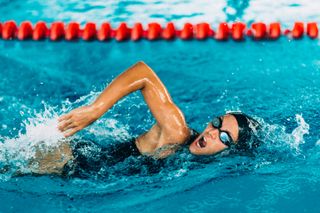Most of us have busy lives, packing in cycling alongside work, family commitments and more – making ‘quick wins’ extremely inviting. But, do they work? In our weekly series we speak to cyclists of all kinds, to find out what one change they’ve made that’s helped to make them a better bike rider – and ask – will it work for you?
Pete Gascoigne is a GB Cycling Team Strength and Conditioning Coach, working directly with the elite track athletes to ensure they are in perfect condition ahead of World Cup races, World Championship’s and – ultimately – Olympic Games’. He worked closely with the Women’s Endurance Track Squad ahead of the 2020 Tokyo Olympics, where they gained gold (Katie Archibald and Laura Kenny in the Madison) and silver medals (Elinor Barker, Katie Archibald, Laura Kenny, Neah Evans, Josie Knight in the team pursuit)
Gascoigne is a keen cyclist himself, but with a role that demands travel away from his own bike, balancing his own cycling fitness while helping others reach their peak performance must be be tricky.
Asking Gascoigne how he manages to do this, his reply is simply “always pack your trainers”.

Peter Gascoigne stands with the British Cycling women’s track squad in track centre
(Image credit: Peter Gascoigne)
“I always pack my runners when going on training camps or work trips” Gascoigne tells me, adding that “For me getting up first thing and getting out to explore, run and feel better than when I left is part of the experience of working ‘away’.
“It makes me feel mentally ready, gives me more energy, and in a far better mood to take on the day!
The latest race content, interviews, features, reviews and expert buying guides, direct to your inbox!
“Camps are 2-3 times a year in the preparation phases typically in winter/off-season, another reason to maximise this time, how often can you get up and watch the sunrise on a run in winter in the UK!
“I also find it is a good way to bond with other staff on camps”.
Intrigued to know exactly what sort of training he sets himself when travelling, it seems that mixing it up is the order of the day “I run and gym alternate days” he says, going on to tell me that “this makes things more interesting and gives a good balance to the structure of being away”.
Ever the coach, Gascoigne is conscious to add the importance of recovery days “occasionally we have rest days and I take the time to do that same!” he jokingly concludes.
As someone who travels for work, I can totally get behind Gascoigne’s top tip of always packing your trainers. But how do you manage to keep on top of your cycling fitness if you’re often away from your bike?
Can just packing your trainers really prevent a loss of all the ‘gains’? Or do you just have to use the opportunity to embark on a bit of sightseeing and sunrise watching?
To find out more, I reached out to the perfect expert, an elite cycling soldier.
Expert View

(Image credit: Sean Dodsworth)
Sean Dodsworth is the current captain of the British Army Cycling Road Team, owner and performance director of Leadout Performance coaching. Prior to his redirection in to cycling coaching, Dodsworth was a British Army Physical Training Instructor (PTI), and knows a thing or two about spending long periods away from the bike.
He now uses his experience to promote health coach riders to optimised performance and nurturing mental resilience among his clients.
Dodsworth believes that by packing your trainers you will have so many more avenues to training when you are without the bike, which can be a great way to keep up the habit of training, as well as giving you a good dose of the happy hormones that make us feel good.
“In fact, it’s probably the best thing you can do to help with riding, or any level of health and fitness” he says. “Packing your trainers when travelling without the bike will help you create a good base fitness will allow you to turn to any kind of sport, and become as robust as possible. This is what the military is very good at.”
Thinking about times when cyclists can’t ride, Dodsworth tells me that the trick is not to panic.
“Even if you miss 30 to 40 days of riding a year due to travelling, it could just be the equivalent of just 30 to 40 hours which is nothing in the scheme of things,
“Having your trainers and a plan of when to use them will give you many more options for keeping your training up.”
Dodsworth himself has previously spent periods of up to six months at a time on military operations without so much as a spin bike or a weight rack to train on and, when not on duty, restricted movement to a small secure compound.
Even in this situation, Dodsworth explains that you can still keep up your cycling fitness.
“There’s no calls home or social media to check, so training is a good distraction.”
But with no bike at hand, or even a gym I wonder how any training can get done?
“You quickly figure out what you can do, and adapt” Dodsworth says, adding that “We started off with just running laps of the compound and using water filled bottles for weights.
“On operations like this, I didn’t turn a pedal for six months at a time, and while I needed a few weeks to adapt back to the bike, the fitness was there,” confirming that “versatility and adaptability will always keep you in good condition”.
Although six months without access to a bike will be extreme for most cyclists, Dodsworth believes that everyone should add variety to their regular training, so that when bike time is squeezed, you can easily jump into another form of exercise.
“I like to take a 3D approach to training and not just look at the numbers,” Dodsworth tells me, adding that “being able to take on a park run, Crossfit or Hyrox class will actually benefit your cycling in the long run as it will be strengthening ligaments and tendons.
Keep it up to avid injury
Elephant in the room: heading out for a run on zero run training could result in an injury, pretty quickly. How do you avoid this?
“As a matter of course I always prescribe at least two easy 30 minute maintenance runs a week, so that when you are away from the bike, you are easily able to adapt to spending more time on your feet,” says Dodsworth.
“The key is adding variability to your regular training sessions, this means that not only will you be able to maintain the habit of training when you are away from the bike, but also have a much healthier relationship and experiences lifelong with sport.”
Or – always pack your goggles…

(Image credit: Getty Images)
According to Dodsworth, if you really don’t want to run when you can’t access the bike, then hitting the pool is another great option.
“Swimming is a really good alterative. It’s a totally different plane of movement to cycling, which is always a good thing”, he says, adding that “this not only allows you to keep the habit of showing up and training, but will help your body become more resilient for in the long term”.
We discuss how significant gains can be found in multiple sport participation, especially when it comes to adding weight lifting and running cyclists training plans.
“Even top professional riders are mixing up their training” states Dodsworth, recalling how Cameron Wurf ran a very decent half marathon time of 1:26.55 immediately after the finish of last year’s (2023) Paris Roubaix.
All when and good when you have a background in elite triathlon, the luxury of being paid to train, and can just add in additional training hours. What about the rest of us who are time squeezed or can’t access our bikes and have a cycling specific target? Surely there’s still a requirement for just time on the bike?
“If you’re building towards an event or race, add extra riding load ahead of time, which can then be topped up with either running or gym work while you’re away from the bike,” suggests Dodsworth, referring back to his advice one adding regular variability in training meaning that your body will already be well adapted to non-cycling movement patterns.
“Remember; movement is movement, and seeing beyond a sport in silo, will give you alternative ways to train and being versatile with your training is a much healthier approach to adopt”.
The important part in packing your trainers is, according to Dodsworth, to have a plan.
This way “you have a greater chance of execution” he advises, before clarifying that “it doesn’t need to be totally regimented, it can be as unstructured as ‘I’m going to run twice’ and not committing to a time or distance, but having even a loose plan will help with accountability”.
It’s Dodworth’s last words however that are possibly the biggest take home piece of advice for always packing your trainers and having a do-all approach to training: “When you’re in your 80’s, and you look back at all the sports you’ve be part of and experienced, your never going to regret all these, or all the experiences you had and taking part”.
For a man with the Captaincy of the British Army Road Team, who’s the Performance Director of a cycling coaching business, his last words really put everything in to perspective.
Our view
One upon a time I used to really struggle to spend time off the bike, especially mid-season, worried I’d see all my training being washed away in just a week without cycling.
I wish I had the forethought to have Gascoigne’s approach and Dodsworth’s level headed advice to worry less and enjoy the opportunity to become a better rounded athlete by just packing my trainers. Arguably I could have become a better cyclist by becoming more versatile and resilient in the process.
Thankfully, I’m far less wedded to my cycling these days, and do in fact always try to pack my trainers. While I’m not worried about loosing watts anymore, I do love a sunrise running (or even walking) tour of a new location, and find it’s great way to find some headspace in an otherwise jampacked travel schedule.

